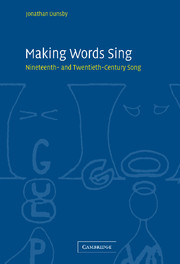Book contents
- Frontmatter
- Contents
- Acknowledgements
- Introduction
- 1 An introduction with no words, with intended words, and untheory
- 2 A love song: Brahms's ‘Von ewiger Liebe’
- 3 Boundless opulence: postscripts on Schoenberg's premonition
- 4 Interlude on peace, laws, flowers, and men flying
- 5 To Amherst via Vienna
- 6 By way of brief conclusion
- Bibliography
- Index
4 - Interlude on peace, laws, flowers, and men flying
Published online by Cambridge University Press: 23 November 2009
- Frontmatter
- Contents
- Acknowledgements
- Introduction
- 1 An introduction with no words, with intended words, and untheory
- 2 A love song: Brahms's ‘Von ewiger Liebe’
- 3 Boundless opulence: postscripts on Schoenberg's premonition
- 4 Interlude on peace, laws, flowers, and men flying
- 5 To Amherst via Vienna
- 6 By way of brief conclusion
- Bibliography
- Index
Summary
Schoenberg appears again now as bridge into the future, to vocal music of the later twentieth century, in order to keep alive a narrative thread from the preceding chapters, and to do so there will be one break in the ‘rule’ of the narrative. Self-evidently this book is concentrating on the song of the solo voice. Song is also, though, at least in my hearing of how Western music ticks, an entity that presents in many forms. One has only to think of the aesthetics of piano playing from Mozart to Chopin and beyond, where making the instrument ‘sing’ is the highest perceived good, and this serves as a reminder of our starting point at the ‘Song without Words’ and a consideration of some of the twists and turns in what that idea did and could mean. Song can certainly be for vocal ensemble, of which Schoenberg's Friede auf Erden is an astonishing representative, choral music at the cutting edge of its compositional time, and raising issues of analytical interpretation not wholly dissimilar from those raised by song in its purest form, solo song. Yet although the ‘solo’ is plain enough in Cathy Berberian's Stripsody, which we shall be visiting as the end-stop of this chapter, it in turn raises the rather more gritty question of what is and what is not ‘song’ in the vocal sense.
- Type
- Chapter
- Information
- Making Words SingNineteenth- and Twentieth-Century Song, pp. 75 - 114Publisher: Cambridge University PressPrint publication year: 2004

